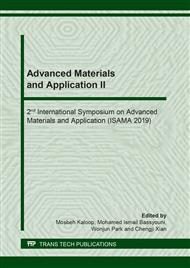[1]
Z. M. Huang, Y. X. Zhou. Strength of Fibrous Composites. Springer Berlin Heidelberg, (2012).
Google Scholar
[2]
G. Cusatis, Z. P. Bažant, L. Cedolin, Confinement-shear lattice CSL model for fracture propagation in concrete. Comp. Meth. Appl. Mech. Eng. 195(52) (2006) 7154-7171.
DOI: 10.1016/j.cma.2005.04.019
Google Scholar
[3]
J. X. Liu, et al., Numerical investigation of crack growth in concrete subjected to compression by the generalized beam lattice model. Comput. Mech. 43(2) (2008) 277-295.
DOI: 10.1007/s00466-008-0305-z
Google Scholar
[4]
J. X. Liu, N. G. Liang, Algorithm for simulating fracture processes in concrete by lattice modeling. Theoret. Appl. Fract. Mech. 52(1) (2009) 26-39.
Google Scholar
[5]
G. Zhang, Interfaces in metal matrix composites. Chinese J. Mater. Res. 11(6) (1997) 649-657.
Google Scholar
[6]
H. N. Yang, et al., Interface microstructure and reaction in Gr/Al metal matrix composites. 31(7) (1996) 1903-1907.
DOI: 10.1007/bf00372206
Google Scholar
[7]
B. Feng, H. S. Liu, R. Q. Lan, A Constraint Model for Interface Stress Element Method without Virtual Elements. Adv. Mater. Res. 671-674(2) (2013) 1574-1577.
DOI: 10.4028/www.scientific.net/amr.671-674.1574
Google Scholar
[8]
A. C. McSwain, et al., Confinement effects on fiber pullout forces for ultra-high-performance concrete. Cem. Concr. Comp. 91(2018) 53-58.
DOI: 10.1016/j.cemconcomp.2018.04.011
Google Scholar
[9]
W. Xu, Y. Wei, Strength and interface failure mechanism of adhesive joints. Int. J. Adhes. Adhes. 34 (2012) 80-92.
Google Scholar
[10]
W. Xu, Y. Wei, Influence of adhesive thickness on local interface fracture and overall strength of metallic adhesive bonding structures. Int. J. Adhes. Adhes. 40 (2013) 158-167.
DOI: 10.1016/j.ijadhadh.2012.07.012
Google Scholar
[11]
V. P. Rajan, F. W. Zok, Matrix cracking of fiber-reinforced ceramic composites in shear. J. Mech. Phys. Sol. 73 (2014) 3-21.
Google Scholar
[12]
A. Zubelwics, Interface element modeling of fracture in aggregate composites. J. Eng. Mech. 113(11) (2016) 1619-1630.
Google Scholar
[13]
Z. P. Bažant, et al., Random Particle Model for Fracture of Aggregate or Fiber Composites. 116(8) (1990) 1686-1705.
Google Scholar
[14]
G. Cusatis, et al., Confinement-Shear Lattice Model for Concrete Damage in Tension and Compression: I. Theory. J. Eng. Mech. 129(12) (2003) 1439-1448.
DOI: 10.1061/(asce)0733-9399(2003)129:12(1439)
Google Scholar
[15]
J. G. M. van Mier, M. R. A. van Vliet, T. K. Wang, Fracture mechanisms in particle composites: statistical aspects in lattice type analysis. Mech. Mater. 34(11) (2002) 705-724.
DOI: 10.1016/s0167-6636(02)00170-9
Google Scholar
[16]
J. X. Liu, et al., Lattice type of fracture model for concrete. Theoret. Appl. Fract. Mech. 48(3) (2007) 269-284.
Google Scholar
[17]
B. L. Karihaloo, F. Shao, Q. Z. Xiao, Lattice modelling of the failure of particle composites. Eng. Fract. Mech. 70(17) (2003) 2385-2406.
DOI: 10.1016/s0013-7944(03)00004-3
Google Scholar
[18]
R. Zhou, Y. Lu, A mesoscale interface approach to modelling fractures in concrete for material investigation. Constr. Build. Mater. 165 (2018) 608-620.
DOI: 10.1016/j.conbuildmat.2018.01.040
Google Scholar


